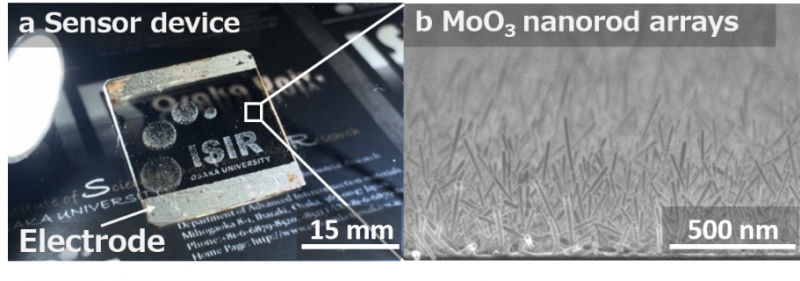Faster manufacturing of breath sensors

A group of researchers at Osaka University, succeeded in producing nanostructured gas sensor devices for detecting volatile organic compounds (VOC) in breath for the purpose of healthcare in time equivalent to or shorter than one tenth of the time required for manufacturing conventional gas sensors. This group improved conventional complicated production methods, developing a simple production method of just sintering substrates applied with materials. This gas sensor's sensing response was comparable to the top-of-the-line sensors reported all over the world.
Research leading detection of low concentrations of gas present in exhaled human breath to health checkups and early detection and treatment of serious diseases is being performed. As gas sensors using nanomaterials can detect various gases even at low concentrations, installing such sensors in electronic healthcare devices is sought after, and research and development are being actively conducted.
Semiconductor gas sensors detect gas through reduced electrical resistance due to gas molecules attached to the surface of crystalline semiconductor materials. For this, gas sensors need a specific surface area of nanomaterials. In order to use nanomaterials for conventional gas sensors, a complicated flow was necessary, from nanomaterials synthesis to cleansing, uniform dispersion of solvent, applying on substrates, and sintering. Thus, there is a concern that manufacturing technology of such gas sensors requires significant time and labor, increasing cost.
A group of researchers led by Assistant Professor Tohru Sugahara (SUGANUMA Lab.) at The Institute of Scientific and Industrial Research, Osaka University, succeeded in producing nanostructured gas sensor devices for detecting volatile organic compounds (VOC) in breath for the purpose of healthcare in time equivalent to or shorter than one tenth of the time required for manufacturing conventional gas sensors. This group improved conventional complicated production methods, developing a simple production method of just sintering substrates applied with materials. This gas sensor's sensing response was comparable to the top-of-the-line sensors reported all over the world.
Since demand in healthcare products is on the rise, there is a lot of activity in research and development of sensors for checking health and disease by examining the gas components of a person's breath. Breathalyzers for finding out who is driving drunk have already been commercialized. Recently, breath sensors for early detection of life-style diseases such as cancer and diabetes have been developed, but most of them are large, bulky and expensive. If gas sensors with high sensitivity are produced thanks to this group's research results, portable breath sensors enabling early detection of diseases will gain popularity.
More information: Shuren Cong et al. Diverse Adsorption/Desorption Abilities Originating from the Nanostructural Morphology of VOC Gas Sensing Devices Based on Molybdenum Trioxide Nanorod Arrays, Advanced Materials Interfaces (2016). DOI: 10.1002/admi.201600252
Provided by Osaka University




















